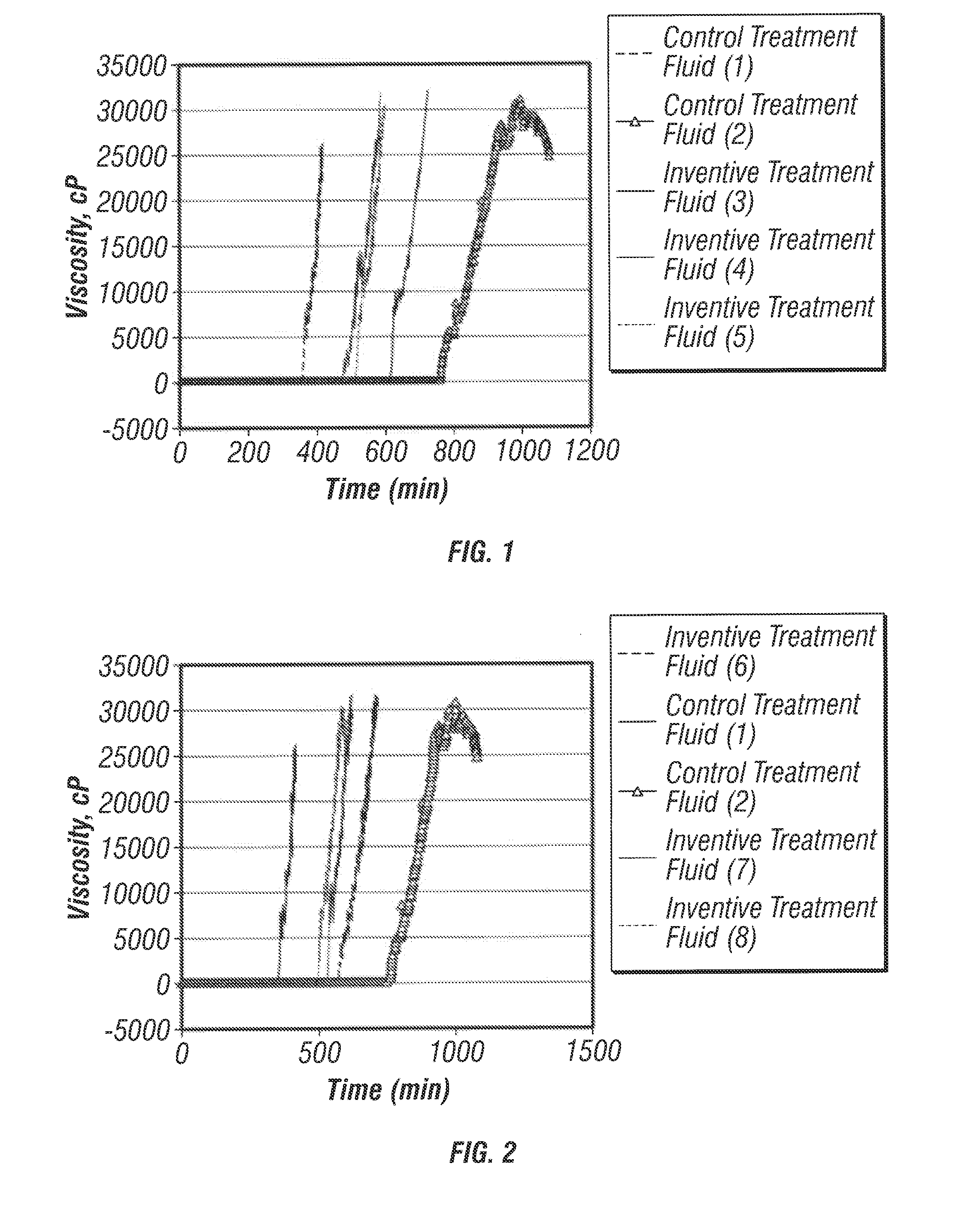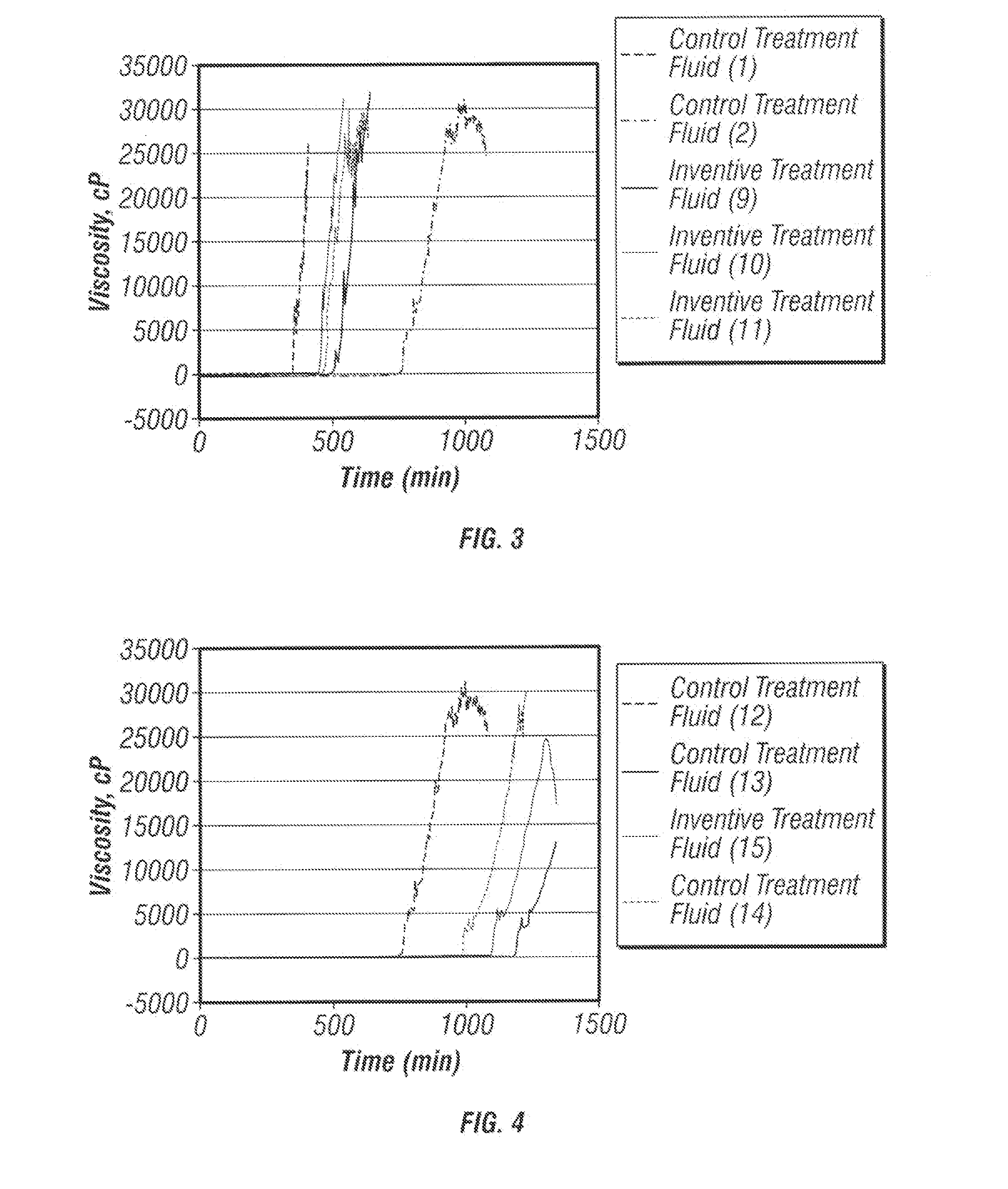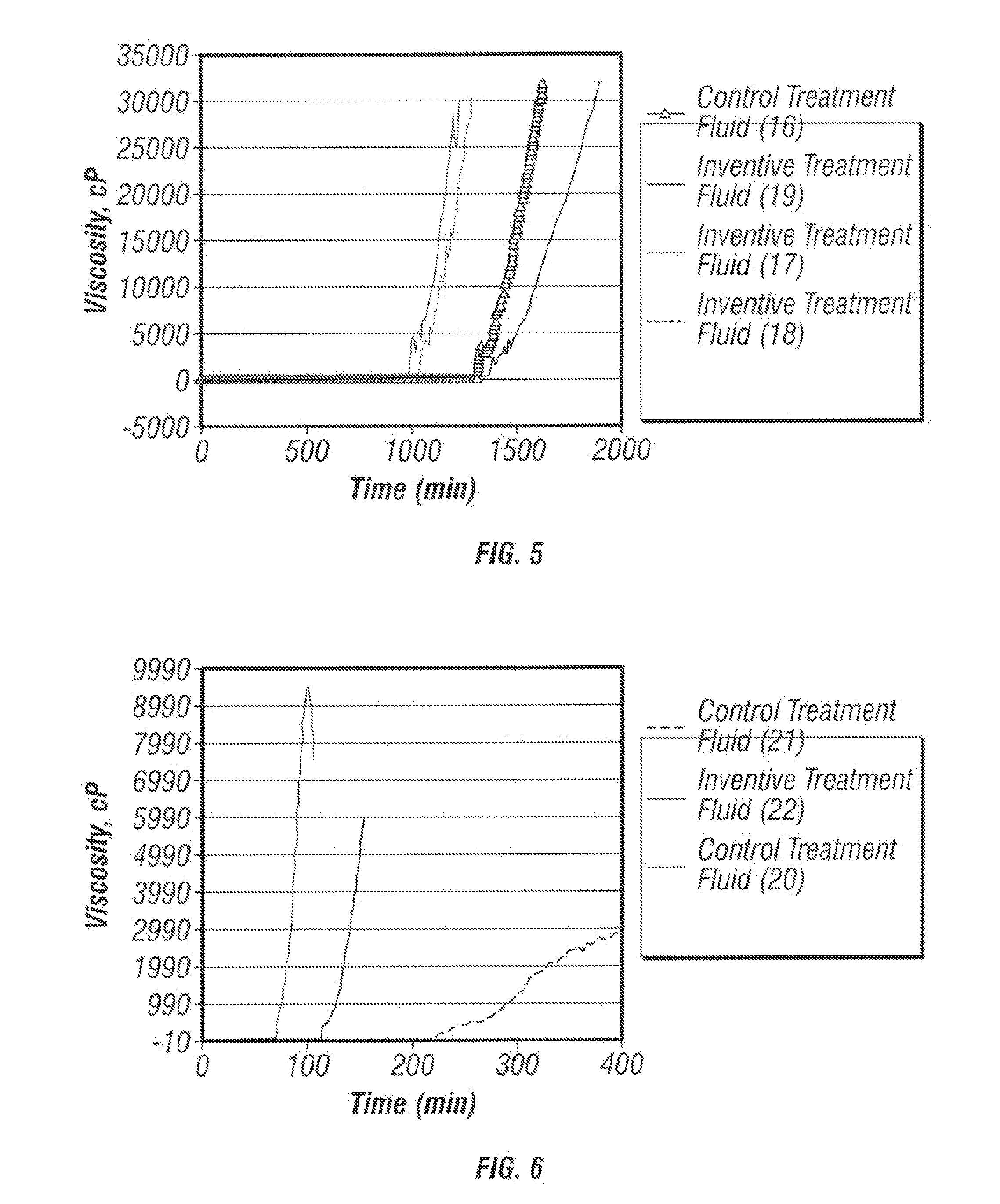Gellable Treatment Fluids Comprising Amino Group Gel-Time Modifiers and Methods for Use Thereof
a gel-time modifier and gel-time technology, which is applied in the direction of sealing/packing, chemistry apparatus and processes, and well accessories, etc., can solve the problems of increasing the cost of separating and disposing water, affecting the production of hydrocarbon-producing wells, and often accompanies water undesirably, so as to reduce the gel-time
- Summary
- Abstract
- Description
- Claims
- Application Information
AI Technical Summary
Benefits of technology
Problems solved by technology
Method used
Image
Examples
example 1
[0061]Gel-times at 160° F. in Cellable Treatment Fluids Comprising a t-Butylacrylate / Acrylamide Base Polymer, Polyethyleneimine, and an Amino Croup-Containing Gel-time Modifier (Reduction of Crosslinkable Polymer Amounts): Control gellable treatment fluids were prepared at the following compositions: (1) 350 gal / Mgal “HZ-10” and 60 gal / Mgal “HZ-20” in 2% aqueous KCl base fluid, and (2) 350 gal / Mgal “HZ-10” and 30 gal / Mgal “HZ-20” in 2% aqueous KCl base fluid. Inventive treatment fluids were prepared at the following compositions: (3) 350 gal / Mgal “HZ-10,” 30 gal / Mgal “HZ-20,” and 0.36% by weight ethanolamine in 2% aqueous KCl base fluid, (4) 350 gal / Mgal “HZ-10,” 30 gal / Mgal “HZ-20,” and 0.75% by weight ethanolamine in 2% aqueous KCl base fluid, (5) 350 gal / Mgal “HZ-10,” 30 gal / Mgal “HZ-20,” and 0.8% by weight diethanolamine in 2% aqueous KCl base fluid, (6) 350 gal / Mgal “HZ-10,” 30 gal / Mgai “HZ-20,” and 0.36% by weight diethylene triamine in 2% aqueous KCl base fluid, (7) 350 gal / M...
example 2
[0064]Gel-times at 160° F. in Gellable Treatment Fluids Comprising a t-Butylacrylate / Acrylamide Base Polymer, Polyethyleneimine, and an Amino Alcohol Gel-time Modifier (Reduction of Base Polymer Amounts): Control gellable treatment fluids were prepared at the following compositions: (12) 350 gal / Mgal “HZ-10” and 30 gal / Mgal “HZ-20” in 2% aqueous KCl base fluid (same as control treatment fluid (2)), and (13) 175 gal / Mgal “HZ-10” and 30 gal / Mgal “HZ-20” in 2% aqueous KCl base fluid. Inventive treatment fluids were prepared at the following compositions: (14) 175 gal / Mgal “HZ-10,” 30 gal / Mgal “HZ-20,” and 0.36% by weight ethanolamine in 2% aqueous KC1 base fluid, and (15) 175 gal / Mgal “HZ-10,” 30 gailMgai “HZ-20,” and 0.5% by volume triethanolamine in 2% aqueous KCl base fluid.
[0065]The viscosities of the above treatment fluids were measured as a function of time in order to determine their gel-times. Viscosity measurements were made at 160° F. FIG. 4 shows an illustrative plot of visc...
example 3
[0066]Gel-times at 160° F. in Gellable Treatment Fluids Comprising a t-Butylacrylate / Acrylamide Base Polymer, Polyethyleneimine, and an Amino Alcohol Gel-time Modifier (Reduction of Base Polymer and Crosslinkable Polymer Amounts). A control gellable treatment fluid was prepared at the following composition: (16) 175 gal / Mgal “HZ-10” and 30 gal / Mgal “HZ-20” in 2% aqueous KCl base fluid (same as control treatment fluid (13)). Inventive treatment fluids were prepared at the following compositions: (17) 175 gal / Mgal “HZ-10,” 30 gal / Mgal “HZ-20,” and 0.36% by weight ethanolamine in 2% aqueous KCl base fluid, (18) 175 gal / Mgal “HZ-10,” 30 gal / Mgal “HZ-20,” and 0.75% by weight ethanolamine in 2% aqueous KCl base fluid, and (19) 175 gal / Mgal “HZ-10,” 30 gal / Mgal “HZ-20,” and 1.55% by weight ethanolamine in 2% aqueous KCl base fluid.
[0067]The viscosities of the above treatment fluids were measured as a function of time in order to determine their gel-times. Viscosity measurements were made a...
PUM
| Property | Measurement | Unit |
|---|---|---|
| temperatures | aaaaa | aaaaa |
| temperature | aaaaa | aaaaa |
| temperature | aaaaa | aaaaa |
Abstract
Description
Claims
Application Information
 Login to View More
Login to View More - R&D
- Intellectual Property
- Life Sciences
- Materials
- Tech Scout
- Unparalleled Data Quality
- Higher Quality Content
- 60% Fewer Hallucinations
Browse by: Latest US Patents, China's latest patents, Technical Efficacy Thesaurus, Application Domain, Technology Topic, Popular Technical Reports.
© 2025 PatSnap. All rights reserved.Legal|Privacy policy|Modern Slavery Act Transparency Statement|Sitemap|About US| Contact US: help@patsnap.com



